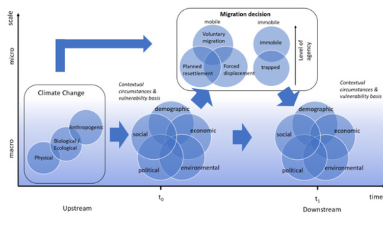Population migration, in short, refers to the movement of people between regions.
This movement can involve short-term or long-term changes in residence, or even permanent migration. There are many different types of population migration, triggered by various factors, including economic, environmental, and policy.
Analysis of Factors Influencing Population Migration
- Climate and Human Migration
Climate is one of the key natural and geographical factors influencing human migration. In ancient times, climate change directly led to large-scale human migration. For example, when the climate becomes colder and drier, areas previously suitable for human habitation may experience food shortages and water shortages. For example, the ancient Yellow River basin was once a thriving human settlement. However, prolonged droughts reduced the flow of the Yellow River, making the land along its banks uncultivable, forcing people to leave and seek more suitable habitats.
Warm and humid climates, on the other hand, often attract human settlements. Tropical rainforests, despite their complex ecological environments, have historically hosted numerous human settlements due to their perennial warmth, rainfall, and abundant resources. Extreme climates have a more pronounced impact on human migration. For example, with the onset of the Ice Age, global temperatures plummeted, and large tracts of land were covered in ice and snow. In search of warmer environments and abundant food, humans were forced to migrate to lower latitudes. Numerous archaeological discoveries confirm this. In Europe, traces of early humans originally living in high-latitude regions gradually decreased with the progress of the Ice Age, while more evidence of contemporary human activity was found along the warmer Mediterranean coast.
- The Role of Topography in Human Migration
Topography is also a key factor influencing human migration. Features such as mountains, rivers, and oceans can hinder or facilitate human migration. Mountains often serve as natural barriers to human migration. For example, the Himalayas limit human interaction between peoples on either side of the mountain range. In ancient times, it was difficult for peoples living on one side of the mountain range to cross and migrate with those on the other side. However, mountains are not completely insurmountable; some mountain passes served as pathways for human migration. For example, the Pamir Plateau, through which the Silk Road passes, despite its rugged terrain, facilitated trade and cultural exchange between the East and the West.
Rivers, on the other hand, have a complex influence on human migration. On the one hand, rivers provide abundant water resources, facilitating agricultural irrigation and human settlement. For example, the Nile River gave birth to ancient Egyptian civilization, and the Yellow and Yangtze Rivers gave rise to Chinese civilization. Early humans often settled along rivers, forming settlements. On the other hand, rivers can also be obstacles to migration. Wide, turbulent rivers can make it difficult for people to cross them directly. However, river crossings and bridges serve as important transportation hubs, facilitating human interaction between different regions. For example, the Yangtze River's ferry crossings have witnessed countless population migrations and cultural exchanges throughout history.
The impact of the ocean on human migration is also not to be underestimated. In ancient times, when navigation was underdeveloped, the ocean posed a formidable obstacle. However, with the development of navigation technology, the ocean has become a crucial channel for humans to transcend geographical boundaries. During the Age of Exploration, Europeans, leveraging advanced navigation technology, opened up shipping routes to various parts of the world. Large numbers of Europeans began migrating to the Americas, Africa, Asia, and other regions, bringing diverse cultures and technologies with them and transforming the world landscape.
- Economic Factors
Economic factors are the most significant factor influencing population migration. With the acceleration of industrialization and urbanization, regional economic imbalances have become increasingly prominent, triggering large-scale population migration. The pursuit of higher incomes and better employment opportunities has become a major driving force for many people to migrate.

